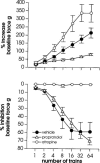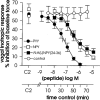Neuropeptide Y is a prejunctional inhibitor of vagal but not sympathetic inotropic responses in guinea-pig isolated left atria
- PMID: 10385237
- PMCID: PMC1566037
- DOI: 10.1038/sj.bjp.0702565
Neuropeptide Y is a prejunctional inhibitor of vagal but not sympathetic inotropic responses in guinea-pig isolated left atria
Abstract
1. The effects of NPY and related peptides were examined on basal contractile force and nerve-mediated inotropic responses to electrical field stimulation of the guinea-pig isolated left atrium. 2. Electrical field stimulus (EFS)-inotropic response curves were constructed by applying 1-64 trains of four field pulses (200 Hz, 0.1 ms duration, 100 V) across isolated left atria (paced at 4 Hz, 2 ms, 1-4 V) within the atrial refractory period. Curves were constructed in presence of vehicle, propranolol (1 microM) or atropine (1 microM) to determine appropriate stimulus conditions. 3. The effects of PYY (1-10,000 nM), NPY (0.01-10 microM), N-Ac-[Leu28,31]NPY(24-36) (N-A[L]NPY(24-36); 0.01-10 microM) and clonidine (0.1-1000 nM) were examined on the positive and negative inotropic responses to EFS (eight trains, four pulses per refractory period). 4. NPY-related peptides had no effect on basal force of contraction nor on the inotropic concentration-response curves to bethanechol or isoprenaline. All three peptides inhibited vagally-mediated negative inotropic responses; rank order of potency PYY>NPY> or =N-A[L]NPY(24-36) was consistent with an action at prejunctional Y2-receptors. Clonidine concentration-dependently inhibited sympathetic inotropic responses. However, PYY, NPY and N-A[L]NPY(24-36) failed to mediate any significant inhibition of the positive inotropic response to EFS. 5. These data demonstrate that NPY is an effective inhibitor of vagal but not sympathetically-mediated inotropic responses in the guinea-pig isolated left atria. This may suggest that endogenously co-released NPY is important in mediating cross talk between efferent components of the autonomic nervous system modulating cardiac contractility, acting overall to sustain positive inotropic responses.
Figures




Similar articles
-
Role of N-type calcium channels in autonomic neurotransmission in guinea-pig isolated left atria.Br J Pharmacol. 1999 Jun;127(4):927-34. doi: 10.1038/sj.bjp.0702629. Br J Pharmacol. 1999. PMID: 10433500 Free PMC article.
-
Heterogeneity of prejunctional NPY receptor-mediated inhibition of cardiac neurotransmission.Br J Pharmacol. 1999 May;127(1):99-108. doi: 10.1038/sj.bjp.0702519. Br J Pharmacol. 1999. PMID: 10369461 Free PMC article.
-
Differential inhibition of neuropeptide Y on the chronotropic and inotropic responses to sympathetic and parasympathetic stimulation in the isolated, perfused dog atrium.J Pharmacol Exp Ther. 1991 Oct;259(1):38-43. J Pharmacol Exp Ther. 1991. PMID: 1920125
-
Effects of antihypertensive drugs on sympathetic vascular control in relation to neuropeptide Y.J Cardiovasc Pharmacol. 1987;10 Suppl 12:S51-68. J Cardiovasc Pharmacol. 1987. PMID: 2455193 Review.
-
Local cardiac responses--alternative methods of control.Am J Cardiol. 1991 May 6;67(12):6C-10C. doi: 10.1016/0002-9149(91)90066-t. Am J Cardiol. 1991. PMID: 1673588 Review.
Cited by
-
Neuropeptide Y and gamma-melanocyte stimulating hormone (gamma-MSH) share a common pressor mechanism of action.Endocrine. 2009 Jun;35(3):312-24. doi: 10.1007/s12020-008-9141-3. Epub 2009 Apr 11. Endocrine. 2009. PMID: 19363600 Free PMC article.
-
Neuropeptide Y inhibits acetylcholine release in human heart atrium by activation of Y2-receptors.Naunyn Schmiedebergs Arch Pharmacol. 2004 May;369(5):455-61. doi: 10.1007/s00210-004-0930-9. Epub 2004 Apr 22. Naunyn Schmiedebergs Arch Pharmacol. 2004. PMID: 15103451
-
Role of N-type calcium channels in autonomic neurotransmission in guinea-pig isolated left atria.Br J Pharmacol. 1999 Jun;127(4):927-34. doi: 10.1038/sj.bjp.0702629. Br J Pharmacol. 1999. PMID: 10433500 Free PMC article.
References
-
- ALLEN J.M., BIRCHAM P.M.M., EDWARDS A.V., TATEMOTO K., BLOOM S.R. Neuropeptide Y (NPY) reduces myocardial perfusion and inhibits the force of contraction of the isolated perfused rabbit heart. Regulatory Peptides. 1983;6:247–253. - PubMed
-
- ALLEN J.M., GJORSTRUP P., BJORKMAN J.A., EK L., ABRAHAMSSON T., BLOOM S.R. Studies on cardiac distribution and function of neuropeptide Y. Acta Physiol. Scand. 1986;126:405–411. - PubMed
-
- AMERINI S., RUBINO A., FILIPPI S., LEDDA F., MANTELLI L. Modulation by adrenergic transmitters of the efferent function of capsaicin-sensitive nerves in cardiac tissue. Neuropeptides. 1991;20:225–232. - PubMed
-
- ANGUS J.A., HARVEY K. Refractory period field stimulation of right atria: A method for studying presynaptic receptors in cardiac autonomic transmission. J. Pharmacol. Meth. 1981;6:51–64. - PubMed
Publication types
MeSH terms
Substances
LinkOut - more resources
Full Text Sources
Medical
Miscellaneous

